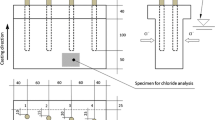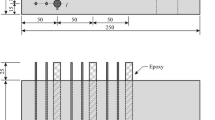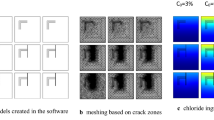Abstract
Information on the chloride threshold level that is necessary to initiate corrosion of steel reinforcement in concrete is required for service life calculations and performance testing of concrete. This paper proposes a method for determining the chloride threshold level causing the corrosion of steel in concrete. The method takes into account the need for accelerated chloride ingress and limitation of possible corrosion of steel parts not intended to act as anode.
Résumé
Le niveau de chlorures au-delà duquel la corrosion des armatures en acier est déclenchée dans le béton renforcé, est un paramètre dont la connaissance est nécessaire aussi bien lors de la conception, que des essais de performance du béton. Une méthode de détermination de ce seuil est proposée dans cet article. La méthode tient compte à la fois de l'accélération induite du flux d'ions chlorure et des limitations liées à une possible corrosion de l'acier.
Similar content being viewed by others
References
Engelund, S., Edvardsen, C. and Mohr, L., ‘General Guidelines for Durability, Design and Redesign, DuraCrete, Probabilistic Performance based Durability Design of Concrete Structures’, The European Union-Brite EURAm III (2000).
BE95-1347/R3, ‘Models for Environmental Actions on Concrete Structures, Task 2 Report’, Chalmers University of Technology, Sweden (2000).
Sandberg, P., ‘Chloride initiated reinforcement corrosion in marine concrete’, PhD thesis, Lund Institute of Technology, Division of Building Materials, Sweden (1998).
Buenfeld, N.R., Glass, G.K., Reddy, B. and Viles, R.F., ‘Process for the protection of reinforcement in reinforced concrete-United States Patent Application 20030075457’, US Patent& Trademark Office (2003).
Alonso, C., Castellote, M. and Andrade, C., ‘Chloride threshold dependence of pitting potential of reinforcement’,Electrochimica Acta 47 (21) (2002) 3469–3481.
Arup, H. and Sørensen, H.E., ‘A proposed technique for determining chloride thresholds’, in ‘Chloride Penetration into Concrete’, RILEM (1995) 460–469.
Trejo, D. and Radhakrishna, G.P., ‘Accelerated chloride threshold testing: Part I-ASTM A 615 and A 706 Reinforcement’,ACI Materials Journal 100 (6) (2003) 57–64.
Frederiksen, J.M., ‘Method for determination of chloride threshold levels for steel in concrete’, Nordtest project no. 1441-99, AE Claboratory, Denmark (2000).
Brodersen, K., ‘CRACK2-Modelling Calcium Carbonate Deposition from Bicarbonate Solution in Cracks in Concrete’, Risø Decommissioning, Risø National Laboratory, Denmark, (2003).
Nygaard, P.V., ‘Effect of steel-concrete interface defects on the chloride threshold for reinforcement corrosion’, Master's thesis—Department of Civil Engineering, Technical University of Denmark, Denmark (2003).
Sørensen, R., ‘Use of electrochemical repair methods in connection with reinforcement corrosion’, PhD Thesis— Department of Civil Engineering, Technical University of Denmark, Denmark (1994) [Only available in Danish].
CEB, ‘Durable Concrete structures: Design Guide: Appendix 1-Curing of concrete structures’ (Thomas Telford Ltd., 1992).
Geiker, M., ‘Studies of Portland cement hydration, measurements of chemical shrinkage and a systematic evaluation of hydration curves by means of the dispersion model’, PhD Thesis—The Institute of Mineral Industry, Technical University of Denmark, Denmark (1983).
NT Build 208, ‘Concrete, Hardened: Chloride content by Volhard Titration’, Nordtest (1996).
Luping, T., ‘Estimation of cement/binder profile parallel to the determination of chloride profile in concrete’, Nordtest project no. 1581-02, SP Swedish National Testing and Research Institute, Building Technology (2003).
Fagerlund, G., ‘The long time water absorption in the air pore structure of concrete’, Avd. byggnadsmaterial LTH, Report TVBM-3051, Lund, Sweden (1993).
Volkwein, A., ‘An investigation on water and chloride transport in concrete’, PhD Thesis—Baustoffinstitut, TU München, Germany (1991) [Only available in German].
Nilsson, L.O., Poulsen, E., Sandberg, P., Sørensen, H.E. and Klinghoffer, O., ‘Chloride penetration into concrete-State of the art’, The Danish Road Directorate, Report no. 53 (1996).
Bager, D.H. and Sellevold, E.J., ‘Ice Formation in Hardened Cement Paste—Part II’, CBL special publication no. 12, Cement and Concrete Laboratory, Aalborg Portland, Denmark (1986).
Glass, G.K. and Buenfeld, N.R., ‘The presentation of the chloride threshold level for corrosion of steel in concrete’,Corrosion Science 39 (5) (1997) 1001–1013.
Author information
Authors and Affiliations
Additional information
Éditorial note Prof. Mette R. Geiker is a RILEM Senior Member. She participates in RILEM TCs 189-NEC ‘Non-destructive evaluation of the ‘covercrete’ (concrete cover)’, 196-ICC ‘Internal curing of concretes’ and RFC ‘Rheology of cement based materials such as fresh concrete’.
Rights and permissions
About this article
Cite this article
Nygaard, P.V., Geiker, M.R. A method for measuring the chloride threshold level required to initiate reinforcement corrosion in concrete. Mat. Struct. 38, 489–494 (2005). https://doi.org/10.1007/BF02482145
Received:
Accepted:
Issue Date:
DOI: https://doi.org/10.1007/BF02482145




